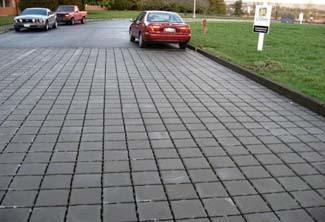Using Cost-Effective Tools for Assessment of Infiltration at Green Infrastructure Stormwater Management Sites
Published March 18, 2020
 An example of permeable pavement.
An example of permeable pavement.
As signs of urban expansion continue across the United States, so do the potential impacts of urban space on environmental quality and natural resources including our landscape. Urban development often leads to the removal of vegetation and regrading of soil, and installation of impervious or semi-impervious surfaces like, buildings, concrete and asphalt. This disturbance is closely connected to deteriorating urban water quality and enhanced flood risks resulting from stormwater runoff.
Green infrastructure (GI) is a group of approaches to water management that protects, restores, or mimics the natural water cycle. It incorporates both the natural environment and engineered systems to provide clean water, protect ecosystem functions, and provide a wide variety of benefits to people and wildlife. GI stores excess water during a heavy rainfall and increases water infiltration into the subsurface or groundwater. The use of GI can be a cost-effective approach to managing wet weather impacts and reducing stresses on combined sewer overflow systems. However, technical guidance is needed on use of below-ground monitoring approaches to evaluate GI system performance. Many existing approaches to performance evaluation do not incorporate monitoring GI for its effects on groundwater quality after installation.
To help determine the best approaches for monitoring the effects of GI on groundwater quality, EPA scientists initiated two pilot studies to test the performance of subsurface monitoring devices and their ability to track movement of infiltrating stormwater into the ground and through different layers of soil.
In one of these studies, EPA is collaborating with the U.S. Army Corps of Engineers as part of their NetZero initiative in Ft. Riley, Kansas, to demonstrate green infrastructure technologies. The Army installed a permeable pavement parking lot behind Seitz Elementary School at Fort Riley. EPA scientists are examining the long-term effectiveness of permeable pavement as an alternative to traditional impervious asphalt pavement in a parking area.
Rainwater infiltrating through permeable pavement helps minimize the flow potential of contaminants into local water bodies. This process helps reestablish a more natural hydrologic balance and reduce runoff volume by trapping and slowly releasing precipitation into the ground instead of allowing it to flow into storm drains and out to receiving waters like streams, rivers, lakes, or oceans. EPA scientists are looking at ways to precisely measure and monitor groundwater once it moves through the permeable pavement and enters and moves through the soil.
“The tools we are developing are designed for tracking the movement of water below ground through the green infrastructure system. They provide a means to monitor performance over time, and hopefully identify problems before they fully develop,” said Robert Ford, an EPA scientist involved in the studies. “Monitoring subsurface water flow is analogous to someone getting their blood pressure checked periodically. The result doesn’t tell you the reason for poor health, but it gives advanced warning that things are not working as they should.”
The second study involves an on-going collaboration between the EPA and the U.S. Geological Survey (USGS) at their field station in Storrs, Connecticut. For this study, EPA and USGS scientists are looking at the potential of long-term remote monitoring of GI performance. To do this, they have inserted several geophysical probes into a meadow to measure temperature and electrical properties of the soil, as well as into adjacent impermeable and permeable pavement. The scientists are using a weather station to measure rainfall and record data in real-time. Instrumentation developed by EPA scientists allows remote operation and data acquisition from the field station.
“When it rains, we can look at the data from our instrument to make sure the permeable pavement is working correctly,” said Dale Werkema, EPA research geophysicist and principal investigator for this study. EPA scientists are also studying the physical properties of the soil, that change when water is flowing underground. “Our ultimate goal is to use geophysics to inexpensively and efficiently protect our water resources by monitoring the effectiveness of GI-engineered systems,” Werkema stated.
Observations from this study will enable long-term remote monitoring of GI performance and provide a better understanding of how to control stormwater runoff.
Cost-effectiveness is a primary consideration for stormwater managers who are trying to decide how to use GI in their communities. Uncertainty about either life-cycle costs or performance can impede decision making, leading communities to underinvest in GI or to overspend on less cost-effective GI systems. Either result is problematic for a community with a multitude of social and infrastructure needs and limited funds.
Through these research efforts, EPA scientists are working to determine low-cost, reliable, user-friendly tools for monitoring performance of enhanced infiltration systems at GI sites across the country. This will help ensure GI practices are properly maintained and provide the greatest benefit to water resources and the community. The research conducted and tools and models created for these pilot studies offer municipal officials, urban planners, policy makers, and interested community members information on options available to reduce potentially negative water quality impacts associated with existing or future development, and to help achieve long-term sustainability.
